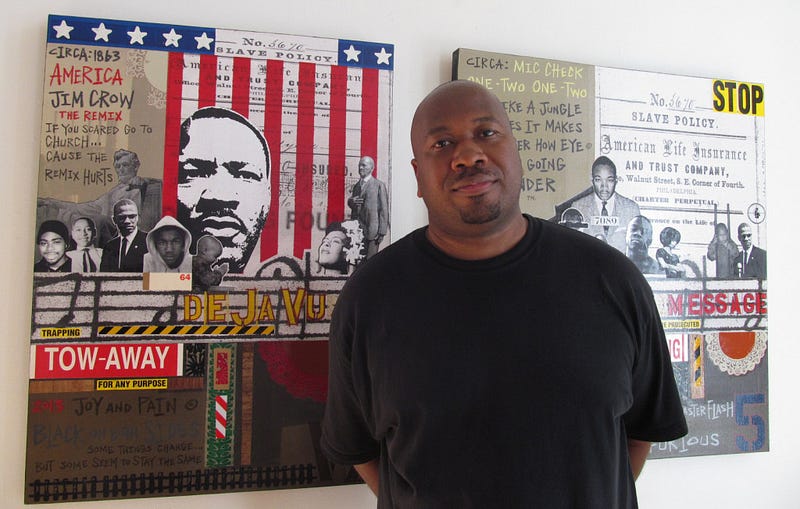
Artist Milton Bowens of Oakland met with Mr. Conley, vice president, and Chardonnae Carter, secretary of the Black Student Union on April 3, at Laney College; June Steingart Gallery.
Bowens is an Oakland native, and his portfolio states that he tactfully put a slim strip of brown paper bag on all his art to connect to his modest past as an artist.
Bowens said, “The most important dimension of painting lives in the zones of silence, emotions, and mystery created by the forms, the lines, the colors, the materials, the brushstroke, and the frailties forged by chance.
“No one would dare say that a painting by Rembrandt or Monet is not an accumulation of abstract passages even if there is a figure. You need simply observe the picture surface to understand the extent to which, if you isolate any given square centimeter, you are immersed in an abstract canvas.”
The following is a question and answer session with Bowens.
Q: Tell me why you are inspired by great artists such as Jean Michel Basquiat, Robert Rauschenberg, Romare Bearden, Jacob Lawrence and Andy Warhol.
A: The short answer is that they all have a unique sense of creativity. I feel that each one of them possess an element of storytelling in their work that intrigues me. I try to incorporate those elements in my own creative process.
Q: Why did you change your focus from illustration to fine art?
A: Illustration is more client-driven. You are given instruction, and you are required to meet the objectives of the client. Fine art allows me to be completely free and fully maximize my abilities to create.
Q: How has the shift been crucial for you now that you are considered a great artist?
A: Well, I don’t know if I am considered a great artist! But, the shift has made it clear that art is a vocation for me and not a job. I felt that illustrating was more of a job, whereas fine art is more of a vocation.
Q: Why is it important to you to be an inspirational public speaker/community activist in the struggle to keep art a vital part of public education and a tool to help build self-esteem in youth?
Why do you work tirelessly to create thought-provoking exhibitions that will help restore a level of hope in communities desperately in need of inspiration?
A: One, because I am a product of a public art school, and I could not be who I am had it not been for that public institution and unique educational experience. I feel that art is one of those unique skillsets that, if fostered and encouraged, allows children to be more like themselves, opposed to following or trying to be like others.
Q: What did the “Talented Ten” do for African Americans to set history on a positive note?
A: Well, their philosophy was to obtain higher education. And through higher education, they became architects to foster higher aspirations for an entire culture.
Q: Tell me about the role of W.E.B. Dubois and the Talented Ten had in African American history, for example he said: “Whether you like it or not the millions are here, and here they will remain. If you do not lift them up, they will pull you down. Education and work are the levers to uplift a people. Work alone will not do it unless inspired by the right ideals and guided by intelligence. Education must not simply teach work — it must teach Life. The Talented Tenth of the Negro race must be made leaders of thought and missionaries of culture among their people. No others can do this work and Negro colleges must train men for it. The Negro race, like all other races, is going to be saved by its exceptional men.”
A: We have to be historically correct. The ideology and philosophy of W.E.B. Dubois in the early stages of the Talented Ten, was that the 10 percent of the enlightened African American race would uplift the remaining 90 percent of the African American culture. But Dubois himself backed away from this philosophy, stating that an empowered 10 percent could take, create, and generate, but never redistribute, wealth and resources beyond anyone but themselves. I truly believe that this shift in ideology has not been widely shared, and understanding that as a race, one shouldn’t have to depend on one small group for the advancement of an entire race of people. It is the obligation of the entire race to want to advance them.
Q: Why do you work tirelessly to create thought-provoking exhibitions that will help restore a level of hope in communities desperately in need of inspiration?
A: Art is only one form of preserving culture. I believe it is one of the most valuable forms of preserving culture, because it is one of the most sacred, honored, and time tested methods of communication that has yet to be censored or tinkered with… It was once said, “If you want to hide information from an uniformed person, put it in a library.” So if we know people don’t go to libraries to truly receive information, I’ll try to sneak that information to them if they happen to come to an art show. I create art to educate, not just decorate.


























